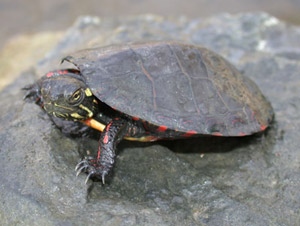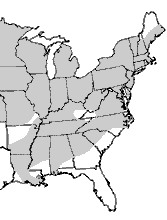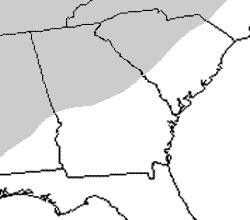Painted Turtle (Chrysemys picta)



Photos by J.D. Willson unless otherwise noted
Description: Painted turtles are relatively small turtles (5-7 in; 10-18 cm carapace length), colorful with dark shells and yellow stripes on the legs and, blotches or spots on their heads. The edges of the shell are smooth, not serrated, and may have red or yellow hieroglyphic-like patterns on the edge of the otherwise yellow or orange-yellow plastron. Southern painted turtles are distinguished from other sub-species by a red or yellow stripe that runs down the carapace from head to tail. Their black legs also have red stripes. Females grow larger than males, but adult males have much longer front claws, which they use in mating displays. Hatchlings look like miniature, more brightly-colored adults.
Range and Habitat: The several subspecies of painted turtles are found across much of the continental US and into Canada. Painted turtles are found in the Piedmont and further inland to the mountains of Georgia and South Carolina. They are rarely but occasionally found below the Fall Line and closer to the coast. They prefer aquatic habitats with vegetation and muddy bottoms including farm ponds, slow-moving rivers and oxbow lakes, freshwater marshes and beaver ponds. They can also be found in roadside ditches and seasonal wetlands.
Habits: Painted turtles have a varied, omnivorous diet and are frequently seen basking on logs or rocks or some other available site. They are most active from March to November, but may be encountered on warm days throughout the year. They mate in early spring (males are known to move between aquatic habitats, presumably looking for mates) with the females coming out of the water to nest during the day in May and June. They typically lay 2-8 eggs, sometimes a few more. The eggs hatch in late summer or early fall, but hatchlings usually remain in the nest until they emerge the following spring. Hatchlings are more carnivorous than adults and grow quickly, sometimes doubling in size in their first growing season.
Conservation Status: Painted turtles are fairly abundant throughout their range. Their ability to adapt to aquatic environments altered by man contributes to the relative stability of many populations of the species.
Pertinent References:
Ernst, Carl H and Jeffrey E. Lovich. 2009. Turtles of the United States and Canada. Johns Hopkins University Press, Baltimore. pp. 184-211.
Congdon, J. D. and D. W. Tinkle. 1982. Reproductive energetics of the painted turtle (Chrysemys picta). Herpetologica 38: 228-237.
Frazer, N. B., J. W. Gibbons, and J. L. Greene. 1991. Growth, survivorship and longevity of painted turtles Chrysemys picta in a southwestern Michigan marsh. The American Midland Naturalist 125: 245-258.
Gibbons, J. W. 1968. Reproductive potential, activity, and cycles in the painted turtle, Chrysemys picta. Ecology 49: 399-409.
Zweifel, Richard G. 1989. Long-term ecological studies on a population of painted turtles, Chrysemys picta, on Long Island, New York. American Museum Novitates (2952): 1-55.
Account Author: Judith Greene, SREL – edited by Whit Gibbons
